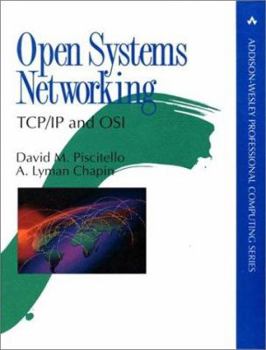Open Systems Networking: TCP/IP and OSI
No Synopsis Available.
Format:Hardcover
Language:English
ISBN:0201563347
ISBN13:9780201563344
Release Date:January 1993
Publisher:Addison Wesley Publishing Company
Length:600 Pages
Weight:2.60 lbs.
Dimensions:1.1" x 7.6" x 9.5"
Customer Reviews
1 rating
An excellent overview of the world of standards
Published by Thriftbooks.com User , 25 years ago
The computing world is full of zealots and bigots. Mac vs. DOS. Ethernet vs. Token Ring. Unix vs. VMS. And TCP/IP vs. OSI. It's like discussing religion, or politics. David Piscitello and Lyman Chapin have to deal with these arguments every day. Open Systems Networking: TCP/IP and OSI (Addison-Wesley, 1993) is their attempt to bring some facts and background into the discussion. Anyone interested in learning the real truth about OSI, its relationship to TCP/IP, and why things are the way they are should be interested in this book. It's a long overdue work, and they've pulled it off beautifully: no other author has explained the two protocol suites, in parallel, understandably and truthfully, as well as Piscitello and Chapin have.If you've been disappointed in other books claiming to "explain" OSI, you'll find Open Systems Networking a refreshing change. It doesn't have the mindless repetition of tables and rewording that William Stallings' books do, nor the "gee this looks dumb" attitude of Marshall Rose's. Piscitello and Chapin served on the national and international standards committees responsible for developing most of the OSI standards. They were there. They know what the standards meant to say, where the bodies are buried, and how to put them all in context. That lets them compare, contrast, explain, and evaluate both OSI and TCP/IP in an honest and straightforward way. Their point of view is a technical one, and not a political one. They advocate the best technology to solve a problem.Open Systems Networking is written for the educated networking professional. It is assumed that the reader has a passable knowledge of TCP/IP. The obligatory presentation of the OSI reference model is at once brief, humorous, and insightful. Most importantly, the explanations of the OSI standards don't get bogged down in explaining trivial details of state machine and protocol header. This is not a book for bit-jerkers. Instead, Piscitello and Chapin focus on the truly important aspects of each standard, identifying what is significant, what is useless, and why it all turned out this way.The discussion of ASN.1, the all-important language for encoding data use in both ISO and some TCP/IP standards is a good example. Half of the space is devoted to a discussion of concepts and reasons why such an encoding is a good idea, as well as a discussion of problems that have occurred in systems that didn't have such an encoding. The other half gives just enough explanation to let an interested reader understand how to read ASN.1. The difference here is between reading a language and writing it. After reading Open Systems Networking, most people will know all they need to know about ASN.1.Knowing that much of their audience will have some TCP/IP bias, Piscitello and Chapin go easier on the home team than they do with their own progeny. For example, when discussing why the OSI transport protocol has




